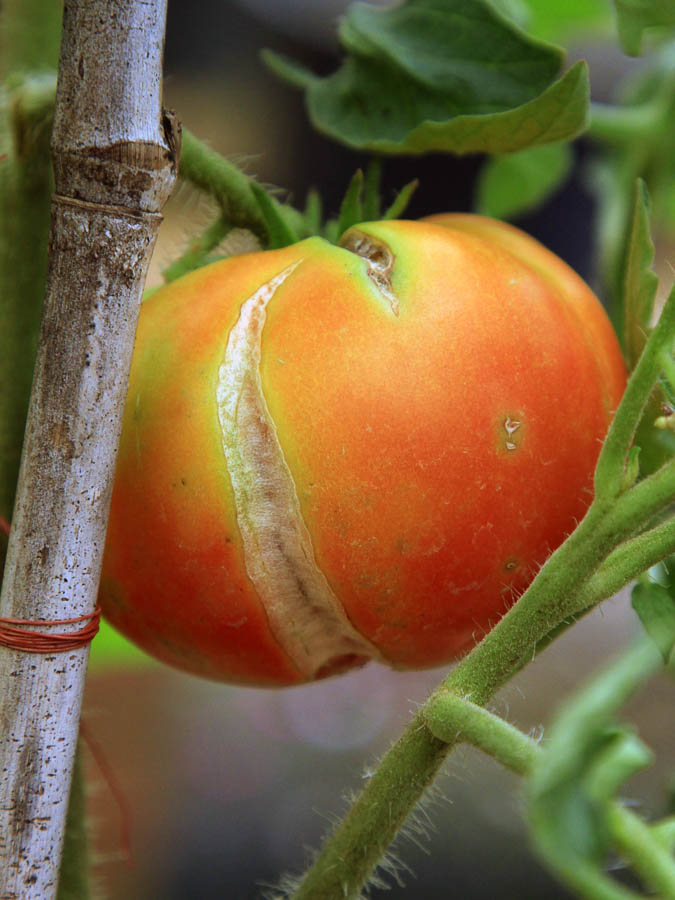Tomato
Tomato (Solanum lycopersicum)
Other common names: 蕃茄, தக்காளி
.jpg)
Tomatoes are a popular crop grown in home and Community Gardens and are often considered one of the most desirable crops for new gardeners to try. There are many Tomato cultivars, with the most common varieties seen in Singapore being heat- and rain-tolerant cherry tomato varieties. Tomatoes are usually red but can also come in other colours like yellow or pink, and range in shape and size depending on the cultivar.
Immature tomatoes can be eaten after they have been cooked, with the most common methods being frying or making them into chutney. Ripe Tomatoes can be eaten raw, in soup, roasted or made into sauces.
As an annual crop, these plants do well as part of scheduled crop rotation.
This plant is part of the Solanum or Nightshade family, which includes other popular edible fruits like Brinjal and Chilli.
Sun and soil needs:
.jpg)
This vine does best in full sun gardens with a minimum of 6 hours of direct sunlight. This plant can also grow with 4-5 hours of direct sunlight and at least 6 hours of indirect sunlight, but will produce less fruits.
Plants do best in pots with loamy soil at least 15cm deep, or in true ground.
Sowing seeds:
Sow seeds individually in a seedling tray filled with potting mix or seedling mix. Lightly mist the soil until damp, once a day. Seeds should sprout within two weeks.
The seedlings will be vulnerable to high heat and heavy rain and are best kept in a sheltered propagation area or a shaded space with around 4 hours of partial or direct sunlight.
Transplanting:
_jacquelinechua.jpg)
Seedlings will be ready for transplanting into pots or true ground when they have developed 4 or more leaves, or roughly a week or two after germination. Leave 15-30cm between each plant to encourage more growth and better ventilation.
Growing:
Tomatoes will produce more flowers and thus more fruit when fed with fertilisers high in Phosphorus and Potassium. Plants can be fertilised once a month after the first flower ins produced for a fuller crop.
Depending on the cultivar, tomatoes can grow as a vine (indeterminate) or as a small shrub (determinate). Vining varieties will need stakes or a trellis to support their growth.
As with all members of the Nightshade family, this plant is buzz-pollinated and produces the most fruit when bees are around to pollinate it. Growing more bee-attracting plants within the garden will encourage pollination.
For both vining and shrub varieties, it is a good practice to prune regularly and remove dead leaves and stems to improve ventilation and allow light to reach more of the plant. Regular pruning also decreases the likelihood of pests quickly taking over the plant. Cuttings can be removed as part of regular pruning and propagated.
Harvesting:
.jpg)
Plants can be harvested for fruits around three months after sowing. The best time to harvest the fruit is in the early morning, before 9am.
Tomatoes can be harvested slightly mature, when they start to flush their final colour, or completely mature, when they no longer have green spots. Immature tomatoes can be eaten after they have been thoroughly cooked. Immature tomatoes can also be left in a cool, dry place to complete the ripening process. Mature tomatoes are shiny, glossy, and will no longer have green spots. They should be easy to pop off the stem with a gentle twist. Seeds can be used from mature fruit for immediate planting.
Harvest cycle:
| Growing period | Sowing to germination | Germination to transplanting | Transplanting to first harvest | Total sowing to first harvest |
|---|---|---|---|---|
| Approximate time | 2 weeks or less | 2 weeks or less | 2 to 3 months | 2 to 3 months |
Check out our sowing and harvest planner to schedule your growing!
Propagation:
Tomatoes are grown from seed or via cuttings rooted in water.
Common problems & solutions:

If your plant has few to no flowers, you can fertilise the plant with fertilisers high in phosphorus and potassium. These nutrients encourage root and flower growth, which are important for the plant to produce more fruit.
As with all members of the Nightshade family, this plant is buzz-pollinated and produces the most fruit when bees are around to pollinate it. Growing more bee-attracting plants within the garden will encourage pollination.
Sudden exposure to large amounts of water, like the first storm of the Monsoon season, can cause fruits to swell and then crack. Protect your plants with a rain shelter during the wet season to prevent this.
Fruit flies can lay eggs in the fruit, resulting in larvae damaging the fruit and creating spots on the skin. Wrap your fruit in netting when it starts to develop from a fertilised flower, ideally after all the petals have dropped off.
Aphids, Mealy Bugs, and Scale Insects often infest the plant if it is waterlogged, wilted from heat stress, or is inconsistently watered. Mechanical pest control methods like pruning the infested parts are the best methods for managing these pests.
Wilting leaves during hot weather is a sign of heat stress. Increase the number of times the plant is watered daily, and apply mulch at the base to prevent water loss.
These plants can get blossom end rot, which shows up as dark, sunken blotches at the end of fruits. It is a symptom of a lack of calcium reaching the fruit, which is usually caused by a lack of water or inconsistent watering. Keep your soil moist but not waterlogged and take care to water more often during the dry season.
This plant is especially vulnerable to root rot caused by waterlogging. It is best to grow the plant in loamy soil with plenty of organic soil amendments and good drainage to prevent this.

